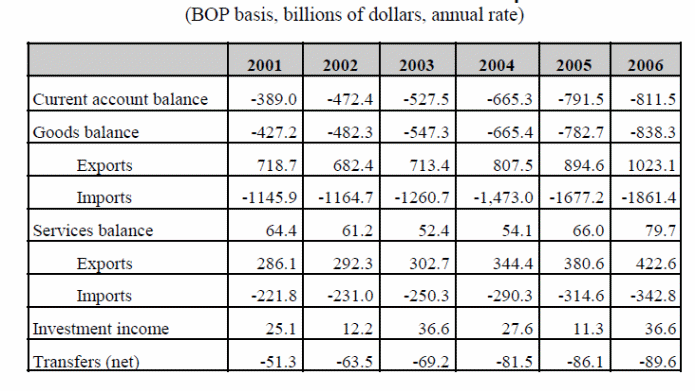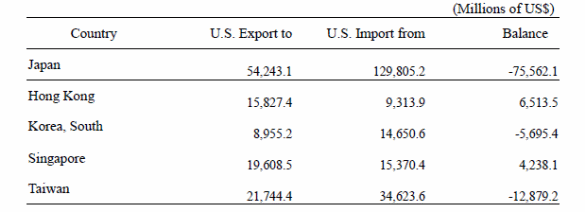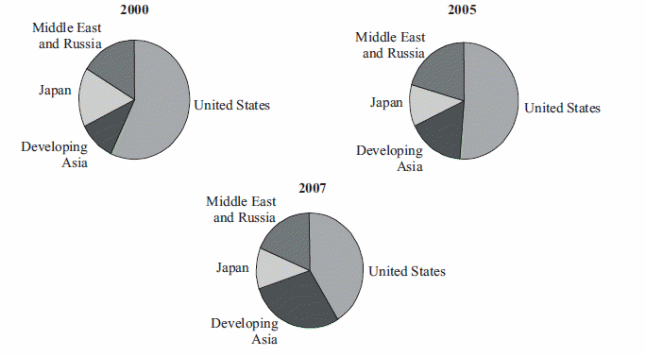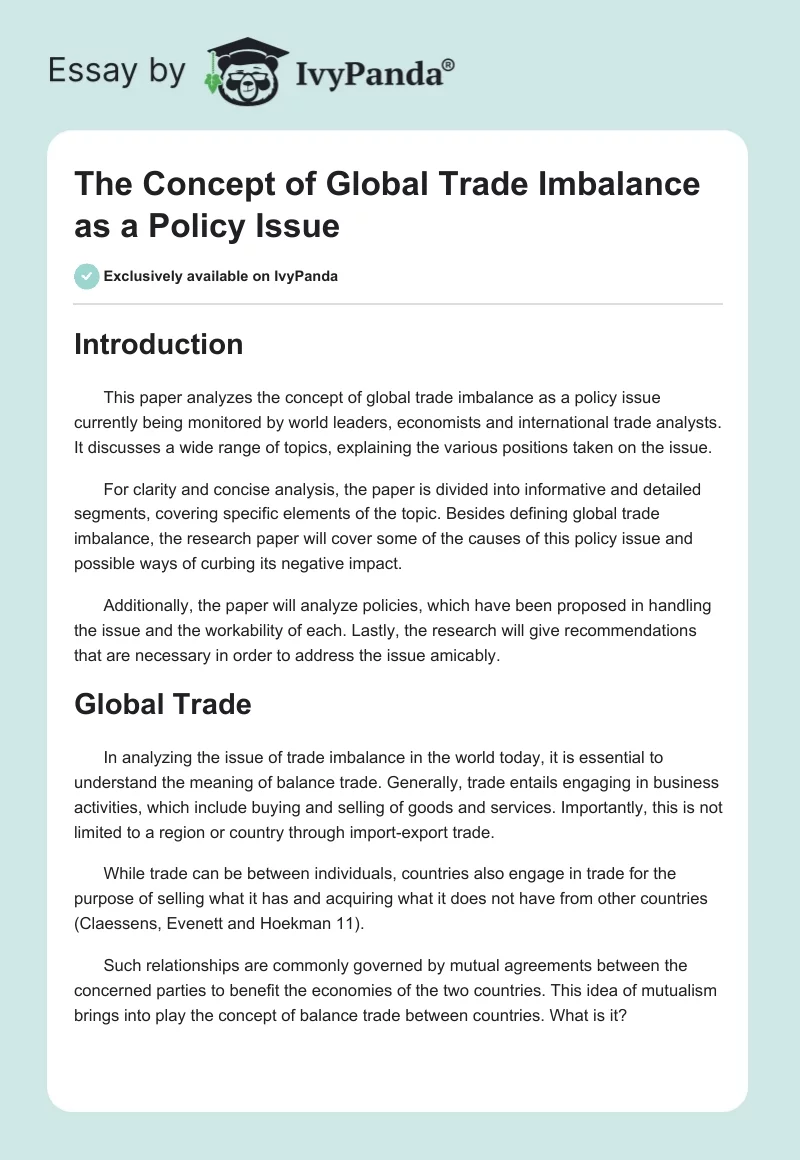Introduction
This paper analyzes the concept of global trade imbalance as a policy issue currently being monitored by world leaders, economists and international trade analysts. It discusses a wide range of topics, explaining the various positions taken on the issue.
For clarity and concise analysis, the paper is divided into informative and detailed segments, covering specific elements of the topic. Besides defining global trade imbalance, the research paper will cover some of the causes of this policy issue and possible ways of curbing its negative impact.
Additionally, the paper will analyze policies, which have been proposed in handling the issue and the workability of each. Lastly, the research will give recommendations that are necessary in order to address the issue amicably.
Global Trade
In analyzing the issue of trade imbalance in the world today, it is essential to understand the meaning of balance trade. Generally, trade entails engaging in business activities, which include buying and selling of goods and services. Importantly, this is not limited to a region or country through import-export trade.
While trade can be between individuals, countries also engage in trade for the purpose of selling what it has and acquiring what it does not have from other countries (Claessens, Evenett and Hoekman 11).
Such relationships are commonly governed by mutual agreements between the concerned parties to benefit the economies of the two countries. This idea of mutualism brings into play the concept of balance trade between countries. What is it?
Economists define balance of trade as the existing monetary difference between exports and imports of a nation over a specified period of time. In other words, the concept of balance of trade relates a country’s exports and imports. This interplay is quite significant in determining the economic benefit or impact of a given relationship between two or more nations.
A positive balance between imports and exports is referred to as trade surplus, and focuses on mores exports compared to imports while a negative relationship results into a trade deficit. Trade deficit is sometimes known as trade gap and emanates from a trading relationship in which a country’s imports exceed its exports within a period of time.
Balance of trade is regarded as a country’s balance of payments (Claessens, Evenett and Hoekman 12). By the fact that countries fight to guard against trade imbalance, it is doubtless that this situation has a host of implications as it shall be discussed later in the research paper.
Global trade imbalance therefore refers to cases in which countries are importing more that what they are exporting. This can be an overall status of a country’s economy or an existing scenario based on its economic relationship with a specific country (Labonte and Makinen 5).
The table below shows U.S. Current Account and Components:

Source: U.S. Department of Commerce (Bureau of Economic Analysis) and Global Insight. Web.
Causes of global imbalance trade
In the understanding of international trade relationships and their impact, it is important to mention that global trade imbalances are on the increase around the world. For instance, the United States’ account deficit has significantly widened, raising alarm over the stability of the country in future.
On the other hand, countries like Japan, China, and the emerging economies in East Asia have continuously experienced account surpluses, which mainly originate from their bilateral relationships with the United States.
This increase in East Asia’s account surpluses has equally contributed to large reserve accumulation of the dollar, coupled with regulation of the foreign exchange market by most central banks in East Asia.
As a way of controlling exchange rate policy, Malaysia, Hong Kong and China have kept a fixed parity with regard to the United States currency. Moreover, other countries like Korea, Japan and Singapore principally depend on de jure floating system that determines the exchange rate.
Based on this way of operation, it suffices to mention that these markets have extensively manipulated foreign exchange market for their own benefit in maintaining their competitiveness within the export sector.
These trade imbalances between regions around the world have triggered tough debates from all quarters. As a result, many are left wondering about the causes of these imbalances and their possible future implications. However, several discussions have been put forth explaining factors which are believed to have contributed to this scenario.
Low U.S. Savings
According to Xafa 2007, the United States has continuously registered low national savings, starting 2000. This reflects the shift from fiscal surplus to deficit and the ever-decreasing savings among American citizens. The possible effect of this trend is an ultimate pile of external liabilities by the United States, which will result into a fall in the dollar and a rise in interest rates (Xafa 61).
However, this explanation for the rising global trade imbalance is non-convincing because of its inconsistency with observed interest rates and nominal rates.
Additionally, this position fails to explain the reason why the American deficit has been on the increase for the last two decades. The explanation is therefore favorable in explaining the rise in trade imbalances at the onset of the 21st century.
Global Savings Glut
This view focuses on a combination of factors, which have contributed to the rising amount of savings outside the United States. One of these factors is the projected increase in the number of retirees to workers in parts of Europe and Asia.
Additionally, there is lack of investment opportunities in most parts of Asia as the region has remained in the recovery mode since it was struck by the 1997-98 financial crisis (Xafa 61). Another factor is the increase in oil prices, which has also contributed to high surpluses for countries exporting oil to other parts of the world.
This saving glut therefore gives reasons behind the rising trade imbalance, reversal of capital flows to various developing countries around the world and stagnating interest rates. Proponents of this stance argue that the situation can only reverse after some of the factors have been reversed.
Statistics indicate that the year 2004 saw Japan register account surplus of $172 billion, amounting to 3.7% of its Gross Domestic Product. On the other hand, the four emerging economies from Asia had a total surplus of $90 billion, contributing 7.1% of the countries’ overall GDP while China registered $70 billion, amounting to 4.2% of its GDP (McKibbin 3).
As mentioned before, most of these surpluses realized by Asian markets were as a result of their trade partnership with the United States. The U.S. trade deficit with the ten East Asian countries including China and Japan amounted to $284 billion.
The table below shows bilateral trade of U.S. with East Asian Countries, 2004:

Whilst high saving rates experienced in East Asia may have significantly contributed to the prolonged globe imbalances, the recent drop in surpluses is a clear indication of the reduced local demand in the region. Most of the countries in East Asia have not yet fully recovered from the effects of previous economic crises (McKibbin 4).
From the year 1998, the region has maintained low interest, creating room for monetary expansion. East Asia also puts a lot of value on fiscal prudence and the region is yet to consider fiscal expansion as a way of increasing domestic demand even as the IMF keeps an eye on the region.
Revived Bretton Woods view
It has also been viewed that the export-led growth strategy adopted by Asian authorities has significantly contributed to the rising trade imbalances between the United States and East Asia.
Through foreign exchange intervention, East Asian countries are able to resist the appreciation of currency in order to allow Foreign Direct Investment to remain profitable to the region members (Xafa 62).
As a result, most Asian banks have accumulated reserves and account surpluses thus lowering interest rates and promoting Bernanke’s global savings glut. This accumulation of U.S. Treasury by Asian countries is also used as collateral for Foreign Direct Investment.
Portfolio Balance Models
These models give an asset-market framework to internalize the impact of several shocks on the flow of global capital and financial interest rates. It has been explained that capital flows to the American market have increased because of its stable and outstanding growth as compared to other nations like Japan and the Euro zone (Xafa 62).
On the hand, it is viewed that emerging economies are faced with the challenge of producing reliable saving instruments with credible property rights in a politically stable environment.
As a result, interest rate adjustments can only occur if the difference in growth between the United States and East Asia countries reverses or if these developing markets establish better financial systems to allow them produce high-quality products.
Additionally, architects of these models argue that there is a shortage of global financial assets, a trend that has been generated by previous market crises of 1990s and increased saving rate in China (Xafa 62).
Based on these views and models, it is evident that the current global trade imbalances especially between the United States and Asian countries have been caused by countless intertwined factors. As a result of this complexity, finding a solution to address the surrounding issues remains an uphill task for world leaders.
Even as the world considers future policies and proposals, an understanding of the impact of these imbalances is undoubtedly quite significant. The following segment discusses some of the effects of global trade imbalances.
Impact of Global Trade Imbalances
In defining the effects of global trade imbalances, it is imperative to underscore the fact that this scenario always carries negative and positive effects, and the former may exceed the latter based on a wider range of factors.
Trade imbalances can allow extension of trade gains through better allocation of saving and a sensible consumption pattern over a given period of time. In other words, trade deficits and imbalances do not necessarily contribute to economic stagnation and loss of jobs as perceived by most people (McKibbin 4).
Intertemporal Trade
Some of the benefits of trade usually emanate from intertemporal exchanges. This refers to exchanges of current goods and services for future claims on goods and services. It can also be described as an exchange of goods and services for an asset, based on the binding agreement.
For instance, the U.S. undertakes intertemporal trade when it borrows money to import materials necessary for a current investment project. In such a case, the borrowing nation benefits because it can finance higher levels of investment than what its current domestic savings can support (Labonte and Makinen 5).
On the other hand, the lending nation benefits by gaining an asset yielding that is of higher return rate than the existing one in home economy. Due to their differences in expenditure preferences, international asset market allows both nations to improve their economies.
The only difference is that the lender is able to gain in future as the borrower spends outside what the current income can support. Notably, a net borrower is likely to run a trade deficit while a net lender runs a trade surplus. This therefore allows maximum and effective utilization of global resources, proper distribution of investment spending and preferred allotment of a country’s expenditure over time (Elwell 15).
Due to its continuous borrowing trend, the U.S. has accumulated its trade deficit more than before, while countries like Japan have run trade surpluses due to numerous lending opportunities. This has earned her returns on excess savings and created prospects for future spending.
Nevertheless, this trend, where American capital inflows are from developing economies is viewed differently. The U.S. has a stock of high capital that can be used to equip its workers (Labonte and Makinen 5).
Debt Service Burden
Global trade imbalances lead to the growth of foreign obligations. This is measured by the net international investment position (NIIP). Based on this approach, the U.S. was a net creditor in 1981 with an accumulated asset value of $374 billion around the world until net borrowing swung her NIIP to a global debtor of $2.5 trillion by the year 2006 (Elwell 16).
With regard to the U.S. deficit, the surplus on investment income has persisted despite the fact that it has a negative NIIP. This clearly denotes that the U.S. has not experienced a true debt service burden to the country’s economy.
It is worth noting that investment spending has the ability of increasing a country’s capital stock that creates opportunity to widen the capacity of the economy to produce goods and services and better its wellbeing. Importantly, the value of such added output may be enough to settle foreign debts and enhance domestic spending simultaneously. As a result, this eliminates the existence of a true economic burden (Elwell 17).
Instability
Economic instability is regarded as of the most severe effect of global trade imbalances today. This is because foreign investors may opt to pull out their resources and engage in other investment projects elsewhere. There are reasons why some countries may consider taking such a turnaround.
In most cases, suspicion over the ability of the borrower to repay has been seen as the common reason whose end result is usually the pulling out of the lender (Elwell 18). Additionally, the inability to service borrowed capital is increased by the fact that emerging economies do not borrow money in their local currencies.
As a result, a drop in the value of their home currency may result into very high figures than what was initially borrowed. High consumption of a country’s foreign exchange reserves with the hope of surviving on a high-valued currency may also result into payment difficulties.
However, this risk does not apply to the United States since it has strong growth, borrows its home currency and does not fix its exchange rate (Elwell 18).
For the United States, the cost of high outflows emanating from a pullout by foreign investors cannot occur easily due to its large capital market in comparison with foreign capital flows. The country has in recent years increased its credit markets to over $2200 billion.
With a net borrowing of $600-$800 billion, it is doubtless that the figure represents about 25% of its annual credit outflow. Even though the figure is of great significance, gradual withdrawal by foreign investors can become overwhelming for the country to bear (Elwell 19).
The chart below shows distribution of current account imbalances in 2009. From the chart, Asia, Russia and the Middle East, significantly account for the US current account deficit.

Total output and unemployment
From a standard economic analysis, trade imbalance does not lead to a net loss of jobs or output. However, these imbalances can automatically result into a change in the composition of employment and output.
These changes in employment usually occur since all existing forces work towards raising the exchange rate for the dollar, and this increases the cost of incentives necessary to substitute certain foreign output with existing domestic output (Elwell 19).
Nevertheless, this is likely to be stabilized by positive effects derived from foreign inflows generated through other sectors of the economy. In addition, trade imbalances affect import-sensitive industries like textile through a decrease in their output and employment. Conversely, credit-sensitive industries like housing are likely to realize an increase in their output and employment (Elwell 20).
Notably, trade imbalances are known to raise the availability of goods and services to domestic purchasers. This scenario usually prompts the government to spend above its domestic output through importation of foreign output. In both cases, the output realized is used to meet the current domestic demand.
Another reason why imbalances in the United States do not lead to low domestic output and employment is because the economy heavily depends on “intraindustry” trade (Elwell 20). This type of trade ensures that high demand for final products results into increased domestic and foreign output, irrespective of the utilization level.
Trade imbalances and financial crisis
In analyzing the impact of global trade imbalances, it has been argued that the current economic crisis may have been as a result of these imbalances. For instance, the recession and financial crisis have led to massive transfer of jobs to foreign countries.
Besides the loss of these job opportunities, wealth has been transferred abroad. Similarly, trade deficits have killed domestic jobs, leaving millions of people jobless. If there is one billion dollars of manufactured imports, it translates to over 13,000 jobs lost (Davis 1).
Consequently, many Americans have challenges in meeting their needs and buy products, which they used to produce. The housing industry has also been hit as a result of this state of the economy. It therefore follows that global trade imbalances and financial crisis are intertwined issues affecting the world economy.
Sustainability of the Trade Deficit
Although the trade deficit emerging from global imbalances is likely to grow in future, a large trade deficit might not be sustained by affected nations forever. There are adjustments, which are bound to take place and shape the global scene of international trade.
For example, borrowers and lenders will lack the willingness of either borrowing or lending respectively (Elwell 11). In such a case, there is likely to be an orderly decrease of saving-investment imbalance and the trade deficit.
Borrower’s Constraint
Although borrowing on its own might not be a problem, the challenge has always been the ability of the borrower to repay. In most cases, payments to settle debts are to be made at the expense of other financial needs of national concern.
In determining the borrower’s constraint, the ration NIIP/GDP is applied (Elwell 11). However, it is not possible to tell the direction of the ratio with reference to the American case since the country does not have enough experience with high foreign debt to GDP ratio.
Lender’s Constraint
Besides the economic ability of a country, it is imperative to underscore the fact that the willingness of a lender to lend depends on the risk-return profile of the assets owned by the borrower relative to other assets available. The presence of more alternatives that have comparable risk-return prospects, lower the willingness of a country lending its resources to a single borrower (Elwell 12).
Similarly, lack of alternative investment opportunities usually present the opposite of this scenario. Importantly, the presence of these opportunities is mainly influenced by the strength of a country’s economy.
The willingness and ability to invest has an impact on international trade. For instance, the ability to sustain large capital outflow is greatly limited by the lender’s economy and wealth reservoir. For example, some lending countries have smaller economies, which cannot sustain the cash outflow that can be absorbed by other economies like the United States (Elwell 11).
In addition, cross-border lending is limited by the fact that most economies prefer holding assets as compared to other countries even though this preference is decreasing slowly. Lastly, lenders are affected by their consciousness about the stability of the dollar in terms of its exchange rate to avoid making losses emanating from depreciating currencies.
This sensitivity is particularly common in cases where a short-term polio investment agreement between two countries is involved. The implication of this is that expected dollar depreciation would affect investors’ demand for dollar assets (Elwell 12).
Policy Responses to Trade Deficits
In dealing with global trade imbalances, there are policies, which have been designed by economists. These polices can be classified into trade policy responses and macroeconomic policy responses.
Trade policy responses
These policies entail strategies to encourage or slow down the flow of imports and exports, including the adoption or elimination of tariffs and subsidies. However, such implementations will definitely affect the level of trade and its efficiency, without altering the balance of trade (Elwell 22).
In other words, actions introduced on one side to change the situation, trigger a counteractive response from the opposite direction, leading to a balance of the trade equation (McKibbin 6). With this policy, it is possible to reduce the level of trade together with economic benefits from the trade and the overall performance but retain the trade deficit.
Additionally, removal of trade barriers by partners would favor export sales and increase foreigners’ demand for the dollar, promote the dollar’s exchange rate and a resultant increase in imports. In the same way, the adoption of export subsidies is likely to enhance export sales, which would leave the trade unchanged (McKibbin 6).
Macroeconomic Policy Responses
Proponents of this policy argue that global trade imbalance can be well tamed if there is a rebalancing of global expenditure. For instance, the United States is required to cut down its domestic expenditure and the mechanisms of trade surpluses would definitely lead to an increase in domestic spending.
With regard to a saving-investment relationship, the U.S. faces three options. The country may experience a drop in the rate of domestic investment, increase in domestic saving or a combination of the two situations (Xafa 64). Macroeconomic policy can theoretically induce changes in spending and saving flows.
Importantly, the value of the dollar has to drop to trigger spending abroad and at home. This inducement is generally caused by a fall in the dollar’s value, increasing the price of goods from other countries and lowering the price of American goods traded in foreign markets (McKibbin 6).
With monetary policy, halting economic activities and increasing domestic investment rates, can significantly lead to a reduction of domestic investment rate and narrowing of the trade deficit.
Nevertheless, it is important to note that decreasing rate of domestic investment is never given consideration for implementation due to its negative effects on the growth of the economy (Elwell 23). Similarly, raising the domestic saving rate is preferred for a trade imbalance that is of a small magnitude, even though it is viewed as a problematic approach.
Recommendations and conclusion
From the above analysis, it is evident that global trade is a complex problem facing the world economy. It is caused by several factors, which emanate from country’s export capability, willingness to import and the resultant interplay between imports and exports.
A good example is the relationship between the United States and the East Asian market, which has resulted into a trade deficit. In dealing with this imbalance, effective and realistic approaches are necessary.
Works Cited
Claessens, Stijn, Evenett Simon, and Hoekman Bernard. Rebalancing the Global Economy: A Primer for Policymaking. London: CEPR, 2010. Print.
Davis, Jack. The U.S. Trade deficit caused the recession and the financial crisis. I Squared R Element, 2008. Web.
Elwell, Craig. The U.S. Trade Deficit: Causes, Consequences, and Cures. CRS Report for Congress, 2008. Web.
Labonte, Marc, and Makinen Gail. Changing Causes of the U.S. Trade Deficit. CRS Report for Congress, 2008. Web.
McKibbin, Warwick. Transpacific Trade Imbalances: Causes and Cures. Brookings, 2004. Web.
Xafa, Miranda. “Global Imbalances: Do They Matter?” CATO Journal 27.1 (2007): 59-68. Print.


